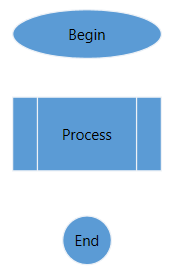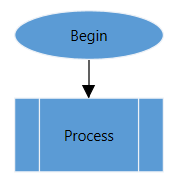Getting Started with UWP Diagram (SfDiagram)
16 Dec 202422 minutes to read
The following section helps you to build your application with SfDiagram.
Creating the project
Create new UWP project using Visual Studio. For more details.
Assembly Reference
Adding control via Designer
SfDiagram control can be added to the application by dragging it from Toolbox and dropping it in Designer view. The required assembly references will be added automatically.

Adding control manually in XAML
In order to add control manually in XAML, do the below steps:
- Add the below required assembly reference to the project, Syncfusion.SfDiagram.UWP .
- Import SfDiagram control namespace Syncfusion.UI.Xaml.Diagram in XAML page.
- Declare SfDiagram control in XAML page.
NOTE
Starting with v16.2.0.x, if you reference Syncfusion® assemblies from trial setup or from the NuGet feed, you also have to include a license key in your projects. Please refer to this link to know about registering Syncfusion® license key in your UWP application to use our components.
<Page
x:Class="Flow_Diagram.MainPage"
xmlns="http://schemas.microsoft.com/winfx/2006/xaml/presentation"
xmlns:x="http://schemas.microsoft.com/winfx/2006/xaml"
xmlns:local="using:Flow_Diagram"
xmlns:d="http://schemas.microsoft.com/expression/blend/2008"
xmlns:mc="http://schemas.openxmlformats.org/markup-compatibility/2006"
xmlns:syncDiagram="using:Syncfusion.UI.Xaml.Diagram"
mc:Ignorable="d"
Background="{ThemeResource ApplicationPageBackgroundThemeBrush}">
<Grid>
<syncDiagram:SfDiagram x:Name="Diagram"/>
</Grid>
</Page>Adding control manually in C#
In order to add control manually in XAML, do the below steps:
- Add the below required assembly references to the project, Syncfusion.SfDiagram.UWP.
- Import SfDiagram namespace Syncfusion.UI.Xaml.Diagram.
- Create SfDiagram control instance and add it to the Grid.
using Syncfusion.UI.Xaml.Diagram;
namespace Flow_Diagram
{
public sealed partial class MainPage : Page
{
public MainPage()
{
this.InitializeComponent();
// Initializes the SfDiagram
SfDiagram diagram=new SfDiagram();
Root_Grid.Children.Add(diagram);
}
}
}Flow Chart
Let us create a simple flow chart using SfDiagram.
Initialize the Diagram
The SfDiagram exists in the Syncfusion.UI.Xaml.Diagram namespace. Initialize SfDiagram in XAML as shown in the following code example.
<!--Initializes the SfDiagram in XMAL window-->
<syncDiagram:SfDiagram x:Name="diagram"/>// Initializes the SfDiagram in C#
SfDiagram diagram = new SfDiagram();Initialize Nodes and Connectors
To initialize the Nodes and Connectors properties of the SfDiagram, Nodes property is assigned with the NodeCollection, that is, ObservableCollection of the Node.
Connectors property is assigned with the ConnectorCollection, that is, ObservableCollection of the Connector.
<syncDiagram:SfDiagram.Nodes>
<!--Observable Collection of NodeViewModel-->
<syncDiagram:NodeCollection/>
</syncDiagram:SfDiagram.Nodes>
<syncDiagram:SfDiagram.Connectors>
<!--Observable Collection of ConnectorViewModel-->
<syncDiagram:ConnectorCollection/>
</syncDiagram:SfDiagram.Connectors>//Initialize Nodes with Observable Collection of NodeViewModel.
diagram.Nodes = new NodeCollection();
//Initialize Connectors with Observable Collection of ConnectorViewModel
diagram.Connectors = new ConnectorCollection();Add Nodes
Let us create and add a NodeViewModel with height, width, shape, shape style,specific position, size and Annotation.
Creating a Node
Creating NodeViewModel with Specified Height and Width.
<syncDiagram:NodeViewModel ID="Begin" UnitHeight="40" UnitWidth="120"/>NodeViewModel Begin = new NodeViewModel()
{
ID = "Begin",
UnitWidth = 120,
UnitHeight = 40,
};Adding specific position to Node
<syncDiagram:NodeViewModel ID="Begin" UnitHeight="40" UnitWidth="120" OffsetX="300" OffsetY="60"/>NodeViewModel Begin = new NodeViewModel()
{
ID = "Begin",
UnitWidth = 120,
UnitHeight = 40,
OffsetX = 300,
OffsetY = 60,
};Adding Shape and ShapeStyle to Node
We have provided set of basic shapes for Diagram as ResourceDictionary. In order to use the built-in shapes, Shapes dictionary should be merged in Application.
Please refer to Shapes to know about built-in Shapes.
<ResourceDictionary>
<ResourceDictionary.MergedDictionaries>
<!--Initialize Shapes-->
<ResourceDictionary Source="ms-appx:///Syncfusion.SfDiagram.UWP/Resources/BasicShapes.xaml"/>
</ResourceDictionary.MergedDictionaries>
<!--Style for Shape of the Node-->
<Style TargetType="Path" x:Key="ShapeStyle">
<Setter Property="Fill" Value="#FF5B9BD5"/>
<Setter Property="Stretch" Value="Fill"/>
<Setter Property="Stroke" Value="#FFEDF1F6"/>
</Style>
</ResourceDictionary>
<syncfusion:NodeViewModel ID="Begin" OffsetX="300" OffsetY="60" Shape="{StaticResource Ellipse}" ShapeStyle="{StaticResource ShapeStyle}" UnitHeight="40" UnitWidth="120"/>NodeViewModel Begin = new NodeViewModel()
{
ID = "Begin",
UnitWidth = 120,
UnitHeight = 40,
OffsetX = 300,
OffsetY = 60,
//Specify shape to the Node from built-in Shape Dictionary
Shape = this.Resources["Ellipse"],
//Apply style to Shape
ShapeStyle = this.Resources["ShapeStyle"] as Style,
};Now Node will be looks like,

NOTE
ID sets for each node to identify nodes easily while setting connectors.
Adding Annotation to node
To initialize the Annotation property of the Node and Connector, it is assigned with the annotation collection, that is, ObservableCollection of the IAnnotation.
<!--To apply Style for AnnotationEditorViewModel-->
<Style TargetType="syncfusion:AnnotationEditor">
</Style>NOTE
Annotationsproperty is a collection, which indicates that more than one Annotation can be added to a Node and Connector.
By default,Annotationsproperty of Node and Connector is null.
Now add the Annotation content to Node.
<syncDiagram:NodeViewModel ID="Begin" OffsetX="300" OffsetY="60" Shape="{StaticResource Ellipse}" ShapeStyle="{StaticResource ShapeStyle}" UnitHeight="40" UnitWidth="120">
<syncDiagram:NodeViewModel.Annotations>
<!--Observable Collection of AnnotationEditorViewModel-->
<syncDiagram:AnnotationCollection>
<syncDiagram:AnnotationEditorViewModel Content="Begin"/>
</syncDiagram:AnnotationCollection>
</syncDiagram:NodeViewModel.Annotations>
</syncDiagram:NodeViewModel>// Creating the NodeViewModel
NodeViewModel Begin = new NodeViewModel()
{
ID = "Begin",
UnitWidth = 120,
UnitHeight = 40,
OffsetX = 300,
OffsetY = 60,
//Specify shape to the Node from built-in Shape Dictionary
Shape = this.Resources["Ellipse"],
//Apply style to Shape
ShapeStyle = this.Resources["ShapeStyle"] as Style,
Annotations = new AnnotationCollection()
{
new AnnotationEditorViewModel()
{
Content="Begin",
}
}
};
// Add Node to Nodes property of the Diagram
(diagram.Nodes as NodeCollection).Add(Begin);Now Node will be looks like,
Nodes for Flow Diagram
We can add multiple Nodes with different shapes into diagram as NodeViewModel.
<syncDiagram:NodeCollection>
<!--Begin-->
<syncDiagram:NodeViewModel ID="Begin" OffsetX="300" OffsetY="60" Shape="{StaticResource Ellipse}" ShapeStyle="{StaticResource ShapeStyle}" UnitHeight="40" UnitWidth="120">
<syncDiagram:NodeViewModel.Annotations>
<!--Observable Collection of AnnotationEditorViewModel-->
<syncDiagram:AnnotationCollection>
<syncDiagram:AnnotationEditorViewModel Content="Begin"/>
</syncDiagram:AnnotationCollection>
</syncDiagram:NodeViewModel.Annotations>
</syncDiagram:NodeViewModel>
<!--Process-->
<syncDiagram:NodeViewModel ID="Process" UnitHeight="60" UnitWidth="120" OffsetX="300" OffsetY="140" Shape="{StaticResource PredefinedProcess}" ShapeStyle="{StaticResource ShapeStyle}">
<syncDiagram:NodeViewModel.Annotations>
<syncDiagram:AnnotationCollection>
<syncDiagram:AnnotationEditorViewModel Content="Process"/>
</syncDiagram:AnnotationCollection>
</syncDiagram:NodeViewModel.Annotations>
</syncDiagram:NodeViewModel>
<!--End-->
<syncDiagram:NodeViewModel ID="End" UnitHeight="40" UnitWidth="40" OffsetX="300" OffsetY="225" Shape="{StaticResource Ellipse}" ShapeStyle="{StaticResource ShapeStyle}">
<syncDiagram:NodeViewModel.Annotations>
<syncDiagram:AnnotationCollection>
<syncDiagram:AnnotationEditorViewModel Content="End"/>
</syncDiagram:AnnotationCollection>
</syncDiagram:NodeViewModel.Annotations>
</syncDiagram:NodeViewModel>
</syncDiagram:NodeCollection>//Begin
NodeViewModel Begin = AddNode(300, 60, 120, 40, "Begin", "Ellipse");
//Process
NodeViewModel Process = AddNode(300, 140, 120, 60, "Process", "PredefinedProcess");
//End
NodeViewModel End = AddNode(300, 225, 40, 40, "End", "Ellipse");
// Add Node to Nodes property of the Diagram
(diagram.Nodes as NodeCollection).Add(Begin);
(diagram.Nodes as NodeCollection).Add(Process);
(diagram.Nodes as NodeCollection).Add(End);
//Creating NodeViewModel
public NodeViewModel AddNode(double offsetX, double offsetY, double width, double height, string text, string shape)
{
NodeViewModel node = new NodeViewModel();
node.ID = text;
node.OffsetX = offsetX;
node.OffsetY = offsetY;
node.UnitHeight = height;
node.UnitWidth = width;
//Specify shape to the Node from built-in Shape Dictionary
node.Shape = this.Resources[shape];
//Apply style to Shape
node.ShapeStyle = this.Resources["ShapeStyle"] as Style;
node.Annotations = new AnnotationCollection()
{
new AnnotationEditorViewModel()
{
Content=text,
},
};
return node;
}Finally all Nodes added to diagram and it will be looks like

Add Connectors
Connector is to make connection or link between two Nodes, Ports and Points.
Create Connector With Source Node and Target Node
Here, we have used SourceNodeID and TargetNodeID property of the Connector.These properties will be assigned with ID property of the Node.
<syncDiagram:ConnectorViewModel SourceNodeID="Begin" TargetNodeID="Process"/>ConnectorViewModel connector1 = new ConnectorViewModel()
{
SourceNodeID = "Begin",
TargetNodeID = "Process",
};Adding Connector geometry style
<!--Style for TargetDecorator of the Connector-->
<Style TargetType="Path" x:Key="TargetDecoratorStyle">
<Setter Property="Stroke" Value="Black"/>
<Setter Property="Stretch" Value="Fill"/>
<Setter Property="Fill" Value="Black"/>
<Setter Property="Height" Value="10"/>
<Setter Property="Width" Value="10"/>
</Style>
<!--Style for Geometry of the Connector-->
<Style TargetType="Path" x:Key="ConnectorGeometryStyle">
<Setter Property="Stroke" Value="Black" />
<Setter Property="StrokeThickness" Value="1" />
</Style>ConnectorViewModel connector1 = new ConnectorViewModel()
{
SourceNodeID = "Begin",
TargetNodeID = "Process",
//Apply Style to TargetDecorator
TargetDecoratorStyle = this.Resources["TargetDecoratorStyle"] as Style,
//Apply Style to Geometry of the Connector.
ConnectorGeometryStyle = this.Resources["ConnectorGeometryStyle"] as Style
};
//Add Connector to Connectors property of the Diagram
(diagram.Connectors as ConnectorCollection).Add(connector1);Now output will be,

Connectors for Flow diagram
Now we can connect all nodes using ConnectorViewModel.
<syncDiagram:ConnectorCollection>
<syncDiagram:ConnectorViewModel SourceNodeID="Begin" TargetNodeID="Process" ConnectorGeometryStyle="{StaticResource ConnectorGeometryStyle}" TargetDecoratorStyle="{StaticResource TargetDecoratorStyle}"/>
<syncDiagram:ConnectorViewModel SourceNodeID="Process" TargetNodeID="End" ConnectorGeometryStyle="{StaticResource ConnectorGeometryStyle}" TargetDecoratorStyle="{StaticResource TargetDecoratorStyle}"/>
</syncDiagram:ConnectorCollection>//Creating ConnectorViewModel
ConnectorViewModel connector1 = CreateConnector("Begin", "Process");
ConnectorViewModel connector2 = CreateConnector("Process", "End");
//Add Connector to Connectors property of the Diagram
(diagram.Connectors as ConnectorCollection).Add(connector1);
(diagram.Connectors as ConnectorCollection).Add(connector2);
//Creating ConnectorViewModel
private ConnectorViewModel CreateConnector(string source, string target)
{
ConnectorViewModel connector = new ConnectorViewModel()
{
SourceNodeID = source,
TargetNodeID = target,
//Apply Style to TargetDecorator
TargetDecoratorStyle = this.Resources["TargetDecoratorStyle"] as Style,
//Apply Style to Geometry of the Connector.
ConnectorGeometryStyle = this.Resources["ConnectorGeometryStyle"] as Style
};
return connector;
}Now output will be looks like,
